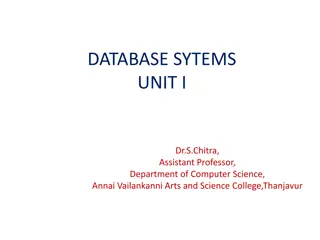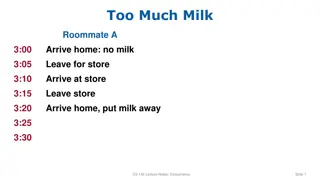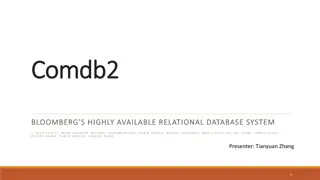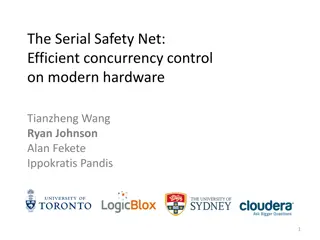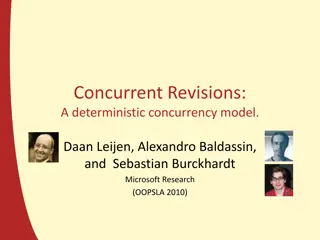Advanced Database Transactions and Concurrency
This content covers topics related to transactions and concurrency in advanced databases, including transaction processing, ACID properties, locking mechanisms, and more. It delves into the challenges of ensuring data consistency and integrity in multi-user database management systems.
Download Presentation

Please find below an Image/Link to download the presentation.
The content on the website is provided AS IS for your information and personal use only. It may not be sold, licensed, or shared on other websites without obtaining consent from the author.If you encounter any issues during the download, it is possible that the publisher has removed the file from their server.
You are allowed to download the files provided on this website for personal or commercial use, subject to the condition that they are used lawfully. All files are the property of their respective owners.
The content on the website is provided AS IS for your information and personal use only. It may not be sold, licensed, or shared on other websites without obtaining consent from the author.
E N D
Presentation Transcript
Transactions and Concurrency COMP3211 Advanced Databases Dr Nicholas Gibbins nmg@ecs.soton.ac.uk
Overview Transaction processing Transaction problems Transaction lifecycle ACID Schedules and serialisability Locking (including 2PL) Timestamps 3
Concurrency In a multi-user DBMS, many users may use the system concurrently Stored data items may be accessed concurrently by user programs 4
Concurrency In a multi-user DBMS, many users may use the system concurrently Stored data items may be accessed concurrently by user programs Transaction: a logical unit of work that changes the contents of a database Group of database operations that are to be executed together 5
When updates go wrong, part one time 6 6
When updates go wrong, part one transaction 1 time 7 7
When updates go wrong, part one User 1 finds seat 22a is empty transaction 1 time 8 8
When updates go wrong, part one User 1 finds seat 22a is empty User 1 books seat 22a transaction 1 time 9 9
When updates go wrong, part one User 1 finds seat 22a is empty User 2 finds seat 22a is empty User 1 books seat 22a User 2 books seat 22a transaction 1 transaction 2 time 10 10
Serial versus Serialisable In an ideal world, we would run transactions serially Transactions runs one at a time, with no overlap In practice, some parallelism is required Too many transactions for serial execution! Transactions should be serialisable Should behave as if they were serial, but may be executed concurrently 11 11
When updates go wrong, part two time 12 12
When updates go wrong, part two Add 100 to account 123 Subtract 100 from account 456 time 13 13
When updates go wrong, part two Add 100 to account 123 CRASH! Subtract 100 from account 456 time 14 14
Atomicity System failure partway through a transaction may leave the database in an inconsistent state Transactions are atomic: operations within a transaction should either all be executed successfully or not be executed at all 15 15
Basic database access operations read(X) Reads a database item Xd into a program variable XT in transaction T write(X) Writes the value of program variable XT in transaction T into the database item Xd 17
Example Transactions T1 T2 read(X) X := X 10 write(X) read(Y) Y := Y+10 write(Y) read(X) X := X + 5 write(X) Initial values: X=20, Y=50 Final values: X=15, Y=60 18
Concurrency Understanding transactions is important for concurrency Operations within a transaction may be interleaved with those from another transaction Depending on how operations are interleaved, database items may have incorrect values 19
The Lost Update Problem Two transactions have operations interleaved so that some DB items are incorrect 20
T1 T2 XT1 YT1 XT2 YT2 Xd Yd 50 20 21 21
T1 T2 XT1 YT1 XT2 YT2 Xd Yd 50 20 read(X) 20 20 50 22 22
T1 T2 XT1 YT1 XT2 YT2 Xd Yd 50 20 read(X) 20 20 50 X := X 10 10 20 50 23 23
T1 T2 XT1 YT1 XT2 YT2 Xd Yd 50 20 read(X) 20 20 50 X := X 10 10 20 50 read(X) 10 20 20 50 24 24
T1 T2 XT1 YT1 XT2 YT2 Xd Yd 50 20 read(X) 20 20 50 X := X 10 10 20 50 read(X) 10 20 20 50 X := X + 5 10 25 20 50 25 25
T1 T2 XT1 YT1 XT2 YT2 Xd Yd 50 20 read(X) 20 20 50 X := X 10 10 20 50 read(X) 10 20 20 50 X := X + 5 10 25 20 50 write(X) 10 25 10 50 26 26
T1 T2 XT1 YT1 XT2 YT2 Xd Yd 50 20 read(X) 20 20 50 X := X 10 10 20 50 read(X) 10 20 20 50 X := X + 5 10 25 20 50 write(X) 10 25 10 50 read(Y) 10 50 25 10 50 27 27
T1 T2 XT1 YT1 XT2 YT2 Xd Yd 50 20 read(X) 20 20 50 X := X 10 10 20 50 read(X) 10 20 20 50 X := X + 5 10 25 20 50 write(X) 10 25 10 50 read(Y) 10 50 25 10 50 write(X) 10 50 25 25 50 28 28
T1 T2 XT1 YT1 XT2 YT2 Xd Yd 50 20 read(X) 20 20 50 X := X 10 10 20 50 read(X) 10 20 20 50 X := X + 5 10 25 20 50 write(X) 10 25 10 50 read(Y) 10 50 25 10 50 write(X) 10 50 25 25 50 Y := Y+10 10 60 25 25 50 29 29
T1 T2 XT1 YT1 XT2 YT2 Xd Yd 50 20 read(X) 20 20 50 X := X 10 10 20 50 read(X) 10 20 20 50 X := X + 5 10 25 20 50 write(X) 10 25 10 50 read(Y) 10 50 25 10 50 write(X) 10 50 25 25 50 Y := Y+10 10 60 25 25 50 write(Y) 10 60 25 25 60 30 30
The Temporary Update (Dirty Read) Problem One transaction updates a DB item and then fails. Item is accessed before reverting to original value. 31
T1 T2 XT1 YT1 XT2 YT2 Xd Yd 50 20 read(X) 20 20 50 X := X 10 10 20 50 write(X) 10 10 50 read(X) 10 10 10 50 X := X + 5 10 15 10 50 write(X) 10 15 15 50 read(Y) 10 50 15 15 50 CRASH! rollback 20 50 32 32
The Incorrect Summary Problem One transaction calculates an aggregate summary function on multiple records while other transactions update records Aggregate function may read some values before they are updated, and some after 33
T1 T2 XT1 YT1 S XT2 YT2 Xd 20 Yd 50 S := 0 0 20 50 read(X) 0 20 20 50 X := X 10 0 10 20 50 write(X) 0 10 10 50 read(X) 10 0 10 10 50 S := S + X 10 10 10 10 50 read(Y) 10 50 10 10 10 50 S := S + Y 10 50 60 10 10 50 read(Y) 10 50 60 10 50 10 50 Y := Y + 10 10 50 60 10 60 10 50 write(Y) 10 50 60 10 60 10 60 34 34
The Unrepeatable Read Problem One transaction reads an item twice, while another changes the item between the two reads T1: T2: read(X) read(X) X := X 10 write(X) read(X) 35
Transaction Processing When a transaction is submitted for execution, the system must ensure that: All operations in the transaction are completed successfully, with effect recorded permanently in the database, or There is no effect on the database or other transactions Transactions may be read-only or update 36
Transaction Life Cycle Need to track start and end of transactions, and commit and abort of transactions BEGIN_TRANSACTION READ, WRITE END_TRANSACTION COMMIT_TRANSACTION ROLLBACK (or ABORT) 37
Transaction Life Cycle READ, WRITE Partially Committed Active Committed BEGIN TRANSACTION END TRANSACTION COMMIT ABORT ABORT Failed Terminated 38
ACID Properties Atomicity A transaction is either performed completely or not at all Consistency Correct transaction execution must take the database from one consistent state to another Isolation A transaction should not make updates externally visible (to other transactions) until committed Durability Once database is changed and committed, changes should not be lost because of failure 40
Schedules A schedule S of n transactions is an ordering of the operations of the transactions, subject to the constraint that for each transaction T that participates in S, the operations in T must appear in the same order in S that they do in T Two operations in a schedule are conflicting if: They belong to different transactions and They access the same data item and At least one of the operations is a write() 41
Serial and Serialisable A schedule is serial if, for each transaction T in the schedule, all operations in T are executed consecutively (no interleaving), otherwise it is non-serial A schedule S of n transactions is serialisable if it is equivalent to some serial schedule of the same n transactions 42
Schedule Equivalence Two schedules are result equivalent if they produce the same final state on the database Two schedules are conflict equivalent if the order of any two conflicting operations is the same in both schedules 43
Serial Schedule T1;T2 T1 read(X) X := X 10 write(X) read(Y) Y := Y + 10 write(Y) T2 read(X) X := X + 5 write(X) XT1 YT1 XT2 YT2 Xd 20 10 10 10 50 10 60 10 60 10 60 10 10 60 15 10 60 15 Yd 50 50 50 50 50 50 60 60 60 60 20 20 20 10 10 10 10 10 10 15 44 44
Serial Schedule T2;T1 T1 read(X) X := X 10 write(X) read(Y) Y := Y + 10 write(Y) T2 read(X) X := X + 5 write(X) XT1 YT1 XT2 YT2 Xd 20 25 25 25 25 15 25 15 25 15 50 25 15 60 25 15 60 25 Yd 50 50 50 50 50 50 50 50 50 60 20 20 20 25 25 25 15 15 15 15 45 45
Non-Serial and Non-Serialisable Schedule T1 read(X) X := X 10 write(X) read(Y) Y := Y+10 write(Y) T2 read(X) X := X + 5 write(X) XT1 YT1 XT2 YT2 Xd 20 10 10 20 10 25 10 25 10 50 25 10 50 25 10 60 25 10 60 25 Yd 50 50 50 50 50 50 50 50 50 60 20 20 20 20 20 10 10 25 25 25 46 46
Non-Serial but Serialisable Schedule T1 read(X) X := X 10 write(X) read(Y) Y := Y + 10 write(Y) T2 read(X) X := X + 5 write(X) XT1 YT1 XT2 YT2 Xd 20 10 10 10 10 10 15 10 15 10 50 15 10 60 15 10 60 15 Yd 50 50 50 50 50 50 50 50 50 60 20 20 20 10 10 10 15 15 15 15 47 47
Locking Locks are used to synchronise access by concurrent transactions to a database Typically, two lock modes: shared and exclusive Shared: for reading Exclusive: for writing Binary locks (equivalent to exclusive mode only) are also possible, but generally too restrictive 49 49
Lock Operations lock-shared(X) Attempt to acquire a shared lock on X lock-exclusive(X) Attempt to acquire an exclusive lock on X unlock(X) Relinquish all locks on X 50 50




